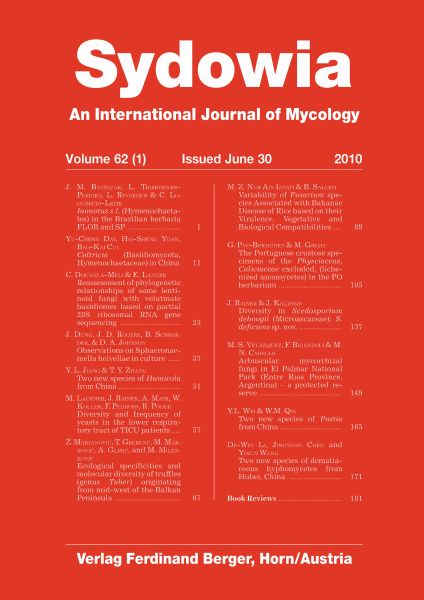
Sydowia Vol. 62/2 E-Book/S 205-223
Entoloma aprile (Agaricales, Entolomataceae) new to Japan,with not
Download-Artikel
Artikel Nr 2571
Preis 10,00 €
Lieferstatus 

Buchbeschreibung
Taiga Kasuya*, Seiji Takehashi**, Tamotsu Hoshino***/****,Machiel E. Noordeloos*****
*Laboratory of Plant Parasitic Mycology, Graduate School of Life and Environmental Sciences, University of Tsukuba, 1-1-1, Ten-nodai, Tsukuba,
Ibaraki 305-8572, Japan
e-mail: tkasuya@sakura.cc.tsukuba.ac.jp
**Non Profit Organization, The Forum of Fungi in Northern Japan, Kanayama
1-3-10-3, Teine-ku, Sapporo, Hokkaido 006-0041, Japan
***Research Institute of Genome-based Biofactory, National Institute of Advanced Industrial Science and Technology (AIST), 2-17-2-1, Tsukisamu-higashi,
Toyohira-ku, Sapporo, Hokkaido 062-8517, Japan
****Graduate School of Science, Hokkaido University, Kita-ku, Sapporo,
Hokkaido 060-0810, Japan
*****National Herbarium of the Netherlands, NL-2300 Leiden, The Nertherlands
Kasuya T., Takehashi S., Hoshino T. & Noordeloos M. E. (2010) Entoloma aprile (Agaricales, Entolo-mataceae) new to Japan, with notes on its mycorrhiza associated with Populus maximowiczii in cool-temperate deciduous forests of Hokkaido. – Sydowia 62 (2): 205–223.
An entolomatoid fungus, Entoloma aprile is newly recorded from Japan. Basidiome morphology of the spe-cies is described and illustrated based on the Japanese specimens. ITS sequences were obtained from Japa-nese E. aprile and three related species, viz. E. clypeatum f. clypeatum, E. clypeatum f. hybridum and E. sepium. Basidiomata of E. aprile were highly homologous (99.4 % – 100.0 %) among our collected speci-mens and were separated from other known Entoloma spp. in the dendrogram based on ITS sequences. This results supported our morphological observation that E. aprile differed from those of allied species. Mycorrhizae of E. aprile on Populus maximowiczii in the cool-temperate deciduous forests of Hokkaido, Japan were observed by stereo, light and scanning electron microscopy for the first time. In studied mycorrhizae, the root cap, meristem, and apical region of the cortex disappeared. Fungal hyphae of the mycorrhizae invaded root tissues. Hyphal sheath outside of the cortex was composed of plectenchymatous and pseudoparenchymatous hyphae divided into three layers according to hyphal thickness and arrangement. Those morphological characteristics suggest that mycorrhizae of E. aprile are of the same type as those of allied Ento-loma species associated with rosaceous and ulmaceous plants.
Keywords: entolomatoid fungi, mycorrhizal morphology, phylogenetic analysis, salicaceous plants, taxonomy




